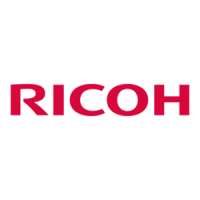Enabling Authentication
59
5
LDAP Authentication
Specify this authentication when using the LDAP server to authenticate users
who have their accounts on the LDAP server. Users cannot be authenticated if
they do not have their accounts on the LDAP server. The address book stored in
the LDAP server can be downloaded to the machine, enabling user authentica-
tion without first using the machine to register individual settings in the address
book.
Limitation
❒ To use LDAP authentication, the network configuration must allow the ma-
chine to detect the presence of the LDAP server.
❒ SSL communication is used for LDAP authentication, so the machine must
have the printer and scanner functions.
❒ To use LDAP authentication you need to register the LDAP server in the ma-
chine. For details about registration, see Network Guide.
❒ Enter the user’s login user name using up to 32 characters and login password
using up to 128 characters.
❒ Enter the administrator’s login user name and login password using up to 32
characters for each.
Note
❒ If the LDAP server is Active Directory, the login user name is specified as
“username@domainname”. However, you can omit the domain name by do-
ing the following: On the Windows server’s [Start] menu, select [Programs],
[Administrative tools], [Active Directory Domains and Trusts]; then, on the [Action]
menu, select [Properties]; and then, in [Active Directory Domains and Trusts Prop-
erties], add the UPN suffix.
Specifying LDAP Authentication
A
AA
A
Press the {
{{
{User Tools/Counter}
}}
} key.
B
BB
B
Press [System Settings].
C
CC
C
Press [Administrator Tools].
D
DD
D
Press [User Authentication Management].
MarC25_EN_SecRef_F_FM.book Page 59 Monday, August 2, 2004 6:14 PM

